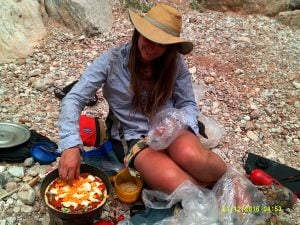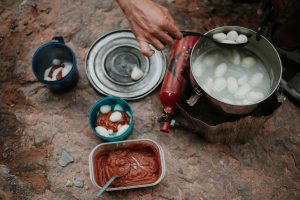Maintaining good nutrition while in the backcountry is essential to good health, peak physical performance, and trip enjoyment. The SROM food system is designed to optimize nutrient quality. Taken into consideration are the unique physical demands of the outdoor experience, weight and bulk of food, ease of food preparation, stove fuel, instructor/participant feedback, and cost. The essential nutritional categories considered are carbohydrates, fats, and proteins. Additionally, water, vitamins, and minerals play key roles in physical performance, as well as awareness and adaptation to extreme outdoor conditions.
Outdoor Nutrition
Proper nutrition in the outdoors requires different nutrient combinations than regular life because you will not only be more active, but while backpacking you also often carry an additional 40-60% of your body weight in equipment and supplies. This extra activity requires 500-1,000 calories per day more than the normal recommended daily allowance (RDA). While our bodies have stores to weather short-term decreases in nutrients, a wilderness course is not the time for dieting! Muscles need fuel to perform. Without appropriate fuel, muscles will break down their own tissue to function, leaving the body progressively weaker. Adipose fat and glycogen stores, which provide cushioning for organs, heat insulation and that last reserve of energy to prevent “bonking,” will also be compromised if the body does not get the fuel it needs.
According to Dr. Braaten, noted outdoor enthusiast and nutritionist, “muscles engaged in long duration moderate intensity exercise burn:
- 25% Fat within the muscle (triglycerides),
- 25% Fat from diet or adipose tissue storage (free fatty acids)
- 25% Carbohydrates within the muscle (glycogen), and
- 25% Glucose (carbohydrate) delivered from the liver (either recycled or from the diet).”
Increasing intensity results in the burning of more carbohydrates.
A balance of all nutrient categories is important. Experts agree that a nutrient ratio of 50% carbohydrates, 35% fat, and 15% protein (50:35:15) is optimal for endurance activities.
Food Types
Food comes in three basic molecular types: carbohydrates, fats, and proteins. Each food type is broken down differently in the body (metabolism) and serves different purposes in keeping a body functioning in a healthy balance.
Carbohydrates
The maintenance of carbohydrate/glycogen stores in the muscles is what determines the body’s endurance. This can be accomplished most efficiently by frequent snacking (20-30 g/hour) on complex carbohydrates and fats. Unlike fat and protein, there are relatively small stores of carbohydrates in the body so it is important to frequently renew these stores through food intake.
Carbohydrates can be classified into simple carbohydrates (sugars) and complex carbohydrates (starches and fiber). Complex carbohydrates are better for maintaining steady energy levels. Never eat simple carbohydrates before exercise because they trigger the release of insulin which causes glucose/blood sugar levels to drop. This is particularly important to keep in mind for hypoglycemics and diabetics.
Carbohydrates within the body are represented by three types of fuel: glucose, lactic acid, and glycogen. Glucose, or blood sugar, is important for brain and muscle functioning during high intensity exercise. Lactic acid is half a glucose molecule due to lack of oxygen during combustion. Lactic acid is converted to glucose by the liver as oxygen levels increase. Glycogen is made up of many glucose molecules joined together and stored in the liver and muscles. Glycogen is the body’s energy reserve. To avoid glycogen depletion, snack often throughout the day and within 1 hour after reaching your destination.
In a SROM food ration, examples of foods that contain complex carbohydratess include oatmeal, grits, brown rice, hash browns, pea soup, and lentils. For gluten-free rations, complex carbohydrates can be found in the garbanzo bean flour, quinoa, and rice chips. Examples of foods that contain simple carbohydrates in a SROM food ration include animal crackers, cheese crackers, pretzels, “bear mush” hot breakfast, pasta, and rice.
Fats
Not only is fat the most energy dense nutrient, but it is also a preferred fuel for exercise. A diet high in fat will spare muscle glycogen, a critical component for endurance. For endurance athletes, half the fat burned is from storage while the other half is from diet. Also, a high fat ration weighs 20% less than a high carbohydrate or high protein ration.
There is little concern that higher fat consumption in the back country will lead to weight gain or clogged arteries (atherosclerosis) because activity levels are increased. In fact, a high fat diet slows digestion, which aids the absorption of nutrients and helps the stomach to feel full longer.
Examples of foods that contain fats in a SROM ration include nuts (e.g., in GORP, granola, lunch mixes), peanut butter or sunbutter, cheeses, butter, olive oil, Snickers® bars, hot cocoa, summer sausage, and other meats (i.e., canned tuna, canned chicken, fresh caught fish).
Proteins
Protein consumption only comprises 10% of the body’s energy needs. Its primary use is the building of muscle tissue. Since most Americans consume two times the RDA of protein, you may find the SROM diet lower in protein than what you normally eat. However, the SROM ration will still be sufficient for your muscle building and energy needs. Athletes should consume 1 g protein/kg body weight (12-15% of the diet). To calculate protein needs for strenuous activity (in g/day) multiply the participant’s weight in pounds by 2.2. This amounts to 4 servings of protein per day. Protein can be found in nuts, beans, cheese, or meat.
Do not supplement with amino acids or eat excess protein. The body does not store excess protein as an energy source for later use. Your body can break down muscle for energy if it needs to, but your body only keeps enough protein to repair muscle damage and dumps the rest. Your body processes all excess proteins through the kidneys. This means the kidneys will only have to work harder eliminating the extra nitrogen and require more water. Excess protein consumption has been found to be harmful to your health.
Examples of foods that contain protein in a SROM food ration include beans, lentils, peanut butter or sunbutter, nuts, powdered milk, cheeses, hummus, summer sausage, and other meats (i.e., canned tuna, canned chicken, fresh caught fish).
So it doesn’t matter whether you are going for 40 days or 4 days. Your nutrition on your trip is one of the key factors in how successful you will be during your time in the wilderness. And, just because you are in the wilderness, doesn’t mean you still can’t eat well on your journey!
**Copywrited SROM Instructor Handbook**
References:
Braaten, B.L. (2004). Thru-Hiker.com. Retrieved March 2009, from Pack Light, Eat Right: http://thru-hiker.com/articles/pack_light_eat_right.php
Kailey, P. (n.d.). On-Trail Nutrition 101. Retrieved March 20, 2009 from backcountry.com: http://www.backcountry.com/store/newsletter/a474/On-Trail-Nutrition-101.html
Mytys, A. (2001). Backcountry Kitchen. Retrieved March 2009, from Andy’s Lightweight Backpacking Site: http://www.geocities.com/amytys/food.htm



